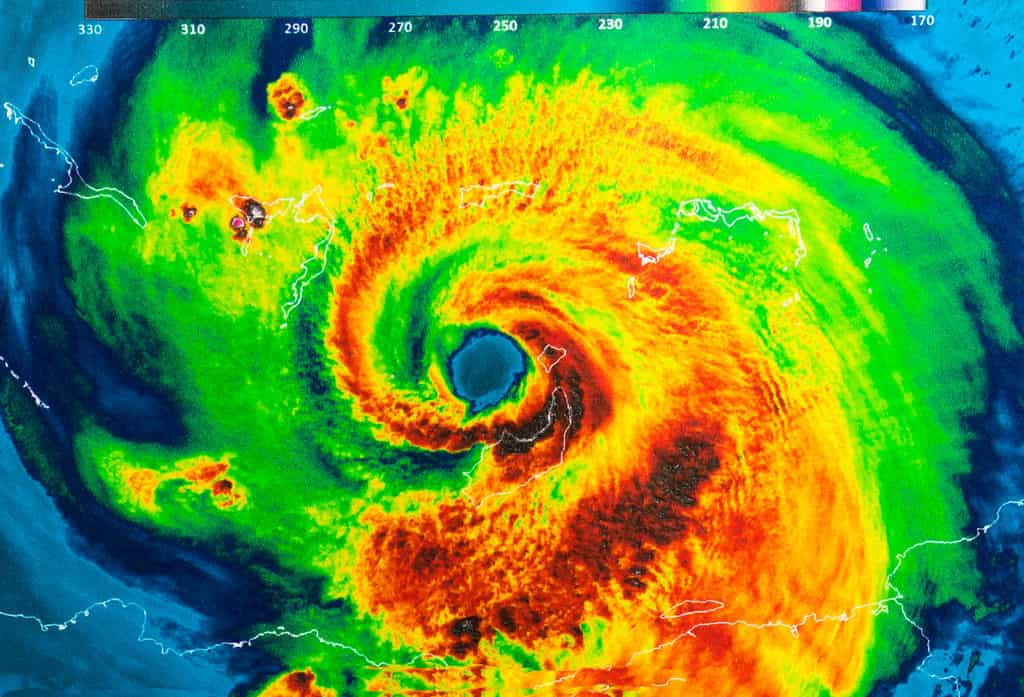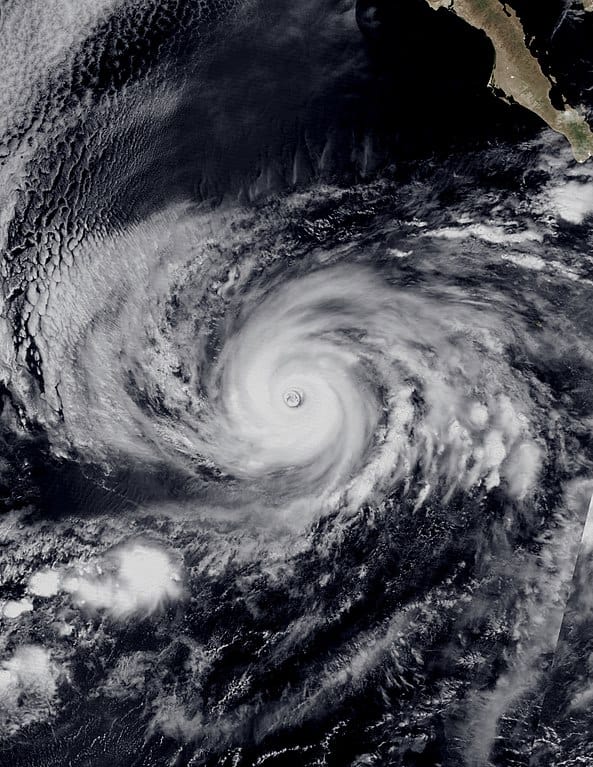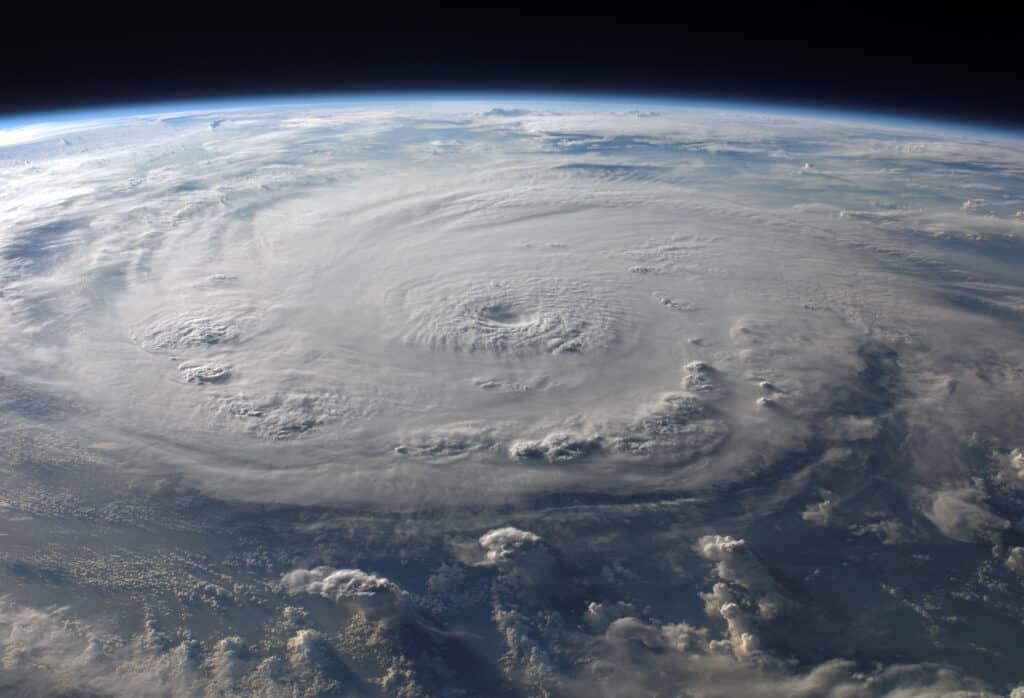There were 157 different storm systems in the 2000s, ranging from tropical depressions to category 5 hurricanes. These storms resulted in a total of 9,152 fatalities (both direct and indirect) and about $306 billion (USD) in damage.
The United States was among the many places affected by these storms. In this article, we are going to address the top 10 biggest hurricanes of this decade (2000–2009) that impacted the U.S., each year.
We will focus on the destruction in dollars and damaged areas, along with any fatalities associated with these hurricanes, below.
1. 2000 – Tropical Storm Leslie

Geocolor Image in the eye of a Hurricane. Elements of this image furnished by NASA.
©Trong Nguyen/Shutterstock.com
| Dates Active | Oct 4 – 7 |
| Category Status | Tropical Storm |
| Damage in Dollars | $950 million |
| Deaths | 3 |
Tropical Storm Leslie was a weak, brief tropical storm that was never well-formed, yet it cost more during the 2000 Atlantic hurricane season than any other tropical cyclone. A wave of low pressure gave rise to Leslie on October 4, 2000, over eastern Florida. As it grew stronger over the open ocean, on October 5 it acquired sufficient traits to be classified as a tropical storm. Before wind shear caused it to deteriorate, the storm had peak winds of 45 mph. On October 7, it became an extratropical cyclone and lasted three additional days before dying out.
In Florida, the harbinger to Leslie caused severe downpours that peaked at 17.5 inches. The flooding resulted in three indirect fatalities and thousands of homes being damaged. $950 million in damages were caused in southern Florida, with agricultural losses accounting for around half of that amount. A part of south Florida was labeled a disaster area as a result.
2. 2001 – Tropical Storm Allison
| Dates Active | June 4 – 18 |
| Category Status | Tropical Storm |
| Damage in Dollars | $9 billion |
| Deaths | 55 |
Southeast Texas was ravaged by Tropical Storm Allison in 2001s’ Atlantic hurricane season. On June 4, 2001, the storm formed in the northern Gulf of Mexico from a tropical wave, and it soon made landfall on the upper coast of Texas. The storm proceeded across the Southeastern and the Mid-Atlantic before turning east-northeast and making landfall in Louisiana.
Over 40 inches of rain fell from the storm in Texas, where it peaked. Houston, the location of most of Allison’s impact, experienced the greatest flooding. After the hurricane inundated more than 70,000 residences and destroyed 2,744 of them, 30,000 people lost their homes. In Texas, 23 people passed away. Allison damaged property of $9 billion (2001 USD) and killed 41 people directly along its whole path (55 total). The worst affected areas, besides Texas, were southeast Pennsylvania and Louisiana.
3. 2002 – Isidore

The peak of Atlantic hurricane season is early September, with most activity between mid-August to mid-October.
| Dates Active | September 14 – 27 |
| Category Status | Category 3 |
| Damage in Dollars | $1.28 billion |
| Deaths | 22 |
In September 2002, Hurricane Isidore, a potent tropical cyclone, devastated Cuba, Mexico, and the United States with extensive flooding and significant damage. Isidore reached its maximum intensity as a Category 3 hurricane, resulting in more than $1 billion in losses and 22 fatalities overall, including four direct deaths in Cuba, Jamaica, Mexico, and the U.S. The storm’s torrential rains that covered southeast Mexico and the Ohio Valley in the middle of the United States had the biggest effects.
4. 2003 – Isabel
| Dates Active | September 6 – 19 |
| Category Status | Category 5 |
| Damage in Dollars | $3.6 billion |
| Deaths | 51 |
The deadliest, most expensive, and most destructive hurricane of the 2003 Atlantic hurricane season was Hurricane Isabel, the fiercest hurricane to hit the Atlantic since Mitch. The massive storm from Isabel in North Carolina swept out a piece of Hatteras Island, creating what was informally referred to as “Isabel Inlet.” The Outer Banks sustained the most damage, with thousands of homes suffering damage or being completely demolished. Isabel’s severe effects were felt in Virginia, particularly in the Hampton Roads region and along the banks of rivers as far as Richmond and Baltimore. The state with the greatest hurricane-related fatalities and damage was Virginia.
Damage ranging from moderate to severe reached inland into West Virginia then moved up the Atlantic coast. The powerful winds of Isabel caused almost six million people in the eastern U.S. to lose access to electricity. From South Carolina to Maine and Michigan, the storm dumped rain. Damage from Isabel’s course amounted to roughly $5.5 billion. The hurricane was directly responsible for 16 fatalities in seven U.S. states and indirectly caused 35 fatalities in six states and one Canadian province.
5. 2004 – Ivan
| Dates Active | September 2 – 24 |
| Category Status | Category 5 |
| Damage in Dollars | $26.07 billion |
| Deaths | 124 |
The Caribbean and the US were severely damaged by Hurricane Ivan, a big, long-lasting Cape Verdean hurricane. When it first developed in early September, Ivan was a Category 5 hurricane according to the Saffir-Simpson Hurricane Scale (SSHS). After reaching its peak intensity, the hurricane traveled in a north-northwesterly direction across the Gulf of Mexico before making a direct hit as a powerful Category 3 storm on Alabama and Pensacola, Florida. As it moved northeast and east across the Eastern United States, Ivan dumped a lot of rain on the Southeast United States.
On September 18, Hurricane Ivan turned into an extratropical cyclone. Then, on September 22, the storm’s residual moved into the western Atlantic and rebuilt into a tropical cyclone. It subsequently proceeded over Florida and the Gulf of Mexico before making minor landfalls in Texas and Louisiana. Ivan cost $26.1 billion in damages, of which $20.5 billion were incurred in the US. 124 people died as a result of the storm’s direct and indirect effects, including 56 fatalities in the United States.
6. 2005 – Hurricane Katrina

Hurricane Katrina as seen from space
©LiL SUS/Shutterstock.com
| Dates Active | Aug 23 – 30 |
| Category Status | Category 5 |
| Damage in Dollars | $125 billion |
| Deaths | 1,836 |
Before the record was surpassed in 2020, the 2005 Atlantic hurricane season was the busiest on record. Hurricane Katrina was by far the biggest hurricane in 2005. It was a deadly Category 5 hurricane that struck in late August 2005 and left more than 1,800 people dead. It caused $125 billion in damage, primarily in New Orleans and nearby areas. On August 26, Katrina made her way into the Gulf of Mexico and momentarily weakened to tropical storm intensity over southern Florida. From there, she quickly picked up intensity. Across the warm seas of the Gulf of Mexico, the storm developed into a Category 5 hurricane. On August 29, 2005, it decreased to Category 3 during its second landfall over Mississippi and southeast Louisiana.
The majority of the fatalities were brought on by flooding, which was mostly a result of deadly engineering defects in the levee system that protected New Orleans from flooding. Most of New Orleans’ communication and transportation infrastructure was also devastated due to the floods. This left tens of thousands of residents who had not fled the city trapped without access to food, shelter, and other essentials.
7. 2006 – Hurricane Ernesto
| Dates Active | Aug 24 – Sept 1 |
| Category Status | Category 1 |
| Damage in Dollars | $500 million |
| Deaths | 11 |
Hurricane Ernesto was the most costly tropical cyclone of the 2006 Atlantic hurricane season. In contrast to initial predictions that it would track into the eastern Gulf of Mexico as a major hurricane, Ernesto passed through eastern Florida as a minor tropical storm. It turned toward the northeast and picked up again. Then, on August 31, it came close to becoming a hurricane as it made landfall on the North Carolina coast. Later that day, Ernesto arrived in southern Virginia and entered the extratropical zone. After bringing rain to the northeastern United States on September 4, the remnants dispersed over eastern Canada.
Ernesto, which caused torrential rains to fall along its course, notably in the Mid-Atlantic area of the United States, was blamed for at least 11 fatalities. As it moved over the Caribbean, Ernesto impacted a number of nations. At first, it presented a threat to the US Gulf Coast around the one-year anniversary of Hurricane Katrina. Virginia was designated as a federal disaster area after damage there was assessed to be worth more than $118 million (2006 USD). $500 million in total damage was believed to have occurred in the US.
8. 2007 – Tropical Storm Erin
| Dates Active | Aug 15 – 17 |
| Category Status | Tropical Storm Erin |
| Damage in Dollars | $248.3 million |
| Deaths | 21 |
Noel was the deadliest hurricane in the North Atlantic during the 2007 hurricane season, it did not do as much damage to the United States as Tropical Storm Erin. In August 2007, a weak tropical storm named Tropical Storm Erin came ashore in Texas. Once over Oklahoma, the storm’s remnant suddenly strengthened, causing more damage. The following day, it upgraded to a tropical storm. Then, on August 16, 2007, Erin made landfall close to Lamar, Texas. It then lingered over Texas’s landscape before heading north towards Oklahoma. The storm made Texas’ already serious flooding problem worse and ultimately caused sixteen fatalities. In total, this storm cost about $248 million in damages and resulted in 21 fatalities.
9. 2008 – Hurricane Ike

The photo was taken amid sea spray and crashing waves as Hurricane Ike’s outer bands impact the Florida coast, in September 2008.
©forestpath/Shutterstock.com
| Dates Active | Sept 1 – 14 |
| Category Status | Category 4 |
| Damage in Dollars | $ 38 billion |
| Deaths | 192 |
With over 1,000 fatalities and around $50 billion in damage, the Atlantic hurricane season of 2008 was the most deadly since 2005. The largest devastation in the US in 2008 was caused by Hurricane Ike, despite Hurricane Hanna being a potent and deadly tropical cyclone that inflicted significant damage over the Western Atlantic.
Hurricane Ike was a potent tropical cyclone that devastated infrastructure and crops, especially in Texas and Cuba, as it moved over parts of the Greater Antilles and North America in September 2008. At least 192 fatalities were attributed to Ike. 74 of these fatalities occurred in Haiti, which was still struggling to recover from the effects of the three storms that hit the country that year—Fay, Hanna, and Gustav. In Cuba, seven individuals perished. As of August 2011, 113 persons were confirmed dead in the United States, either directly or indirectly, and 16 were still missing.
Damage from Ike is estimated to have cost the United States coastal and interior regions $30 billion (2008 USD), $7.3 billion in Cuba, $500 million in Turks & Caicos, and $200 million in the Bahamas, totaling at least $38 billion in damages.
10. 2009 – Hurricane Ida
| Dates Active | Nov 4 – 10 |
| Category Status | Category 2 |
| Damage in Dollars | $11.4 million |
| Deaths | 4 |
During the 2009 hurricane season, Hurricane Ida was the biggest hurricane to make landfall in the Atlantic. It intensified into a Category 2 hurricane before waning and moving across the southeastern United States as an extratropical cyclone. The aftermath of Ida had a huge impact on the east coast of the US. States of emergency were proclaimed by numerous Louisiana parishes, Alabama and Florida counties, and counties in both Alabama and Florida because of the anticipated severe storm damage.
The Mid-Atlantic States in particular were severely damaged by the storms. Numerous flash floods in locations from Maine to Mississippi were caused by widespread heavy rainfall. Ida cost nearly $11 million in damage and resulted in 4 fatalities.
Summary of The Biggest Hurricanes of the 2000s
Here is the summary of the biggest hurricanes of the 2000s:
| Rank | Hurricanes | Year |
|---|---|---|
| 1 | Tropical Storm Leslie | 2000 |
| 2 | Tropical Storm Allison | 2001 |
| 3 | Isidore | 2002 |
| 4 | Isabel | 2003 |
| 5 | Ivan | 2004 |
| 6 | Hurricane Katrina | 2005 |
| 7 | Hurricane Ernesto | 2006 |
| 8 | Tropical Storm Erin | 2007 |
| 9 | Hurricane Ike | 2008 |
| 10 | Hurricane Ida | 2009 |
Thank you for reading! Have some feedback for us? Contact the AZ Animals editorial team.







